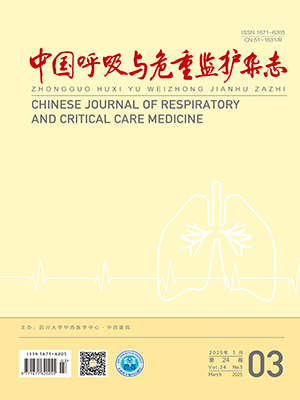| 1. |
Hallowell RW, Danoff SK. Interstitial lung disease associated with the idiopathic inflammatory myopathies and the antisynthetase syndrome: recent advances. Curr Opin Rheumatol, 2014, 26(6): 684-689.
|
| 2. |
Chua F, Higton AM, Colebatch AN, et al. Idiopathic inflammatory myositis-associated interstitial lung disease: ethnicity differences and lung function trends in a British cohort. Rheumatology (Oxford), 2012, 51(10): 1870-1876.
|
| 3. |
陈小波, 罗群, 李时悦. 以急性间质性肺炎为主要症状的多发性肌炎/皮肌炎八例并文献复习. 中国呼吸与危重监护杂志, 2016, 15(6): 589-592.
|
| 4. |
Katzap E, Barilla-LaBarca ML, Marder G. Antisynthetase syndrome. Curr Rheumatol Rep, 2011, 13(3): 175-181.
|
| 5. |
Bohan A, Peter JB. Polymyositis and dermatomyositis (first of two parts). N Engl J Med, 1975, 292(7): 344-347.
|
| 6. |
Bohan A, Peter JB. Polymyositis and dermatomyositis (second of two parts). N Engl J Med, 1975, 292(8): 403-407.
|
| 7. |
Sontheimer RD. Would a new name hasten the acceptance of amyopathic dermatomyositis (dermatomyositis siné myositis) as a distinctive subset within the idiopathic inflammatory dermatomyopathies spectrum of clinical illness?. J Am Acad Dermatol, 2002, 46(4): 626-636.
|
| 8. |
Sato S, Kuwana M. Clinically amyopathic dermatomyositis. Curr Opin Rheumatol, 2010, 22(6): 639-643.
|
| 9. |
Won Huh J, Soon Kim D, Keun Lee C, et al. Two distinct clinical types of interstitial lung disease associated with polymyositis-dermatomyositis. Respir Med, 2007, 101(8): 1761-1769.
|
| 10. |
Koenig M, Fritzler MJ, Targoff IN, et al. Heterogeneity of autoantibodies in 100 patients with autoimmune myositis: insights into clinical features and outcomes. Arthritis Res Ther, 2007, 9(4): R78.
|
| 11. |
Watanabe K, Handa T, Tanizawa K, et al. Detection of antisynthetase syndrome in patients with idiopathic interstitial pneumonias. Respir Med, 2011, 105(8): 1238-1247.
|
| 12. |
Gomard-Mennesson E, Fabien N, Cordier JF, et al. Clinical significance of anti-histidyl-tRNA synthetase (Jo1) autoantibodies. Ann N Y Acad Sci, 2007, 1109(1): 414-420.
|
| 13. |
Hervier B, Devilliers H, Benveniste O. Patients with non-Jo-1 anti-RNA-synthetase autoantibodies have worse survival than Jo-1 positive patients. Ann Rheum Dis, 2013, 72(7): e18.
|
| 14. |
Sontheimer RD. MDA5 autoantibody-another indicator of clinical diversity in dermatomyositis. Ann Transl Med, 2017, 5(7): 160.
|
| 15. |
Lega JC, Fabien N, Reynaud Q, et al. The clinical phenotype associated with myositis-specific and associated autoantibodies: a meta-analysis revisiting the so-called antisynthetase syndrome. Autoimmun Rev, 2014, 13(9): 883-891.
|
| 16. |
林舒缓. 17 例抗 Jo-1 抗体综合征临床分析及文献复习[D]. 福建医科大学, 2012.
|
| 17. |
Solomon J, Swigris JJ, Brown KK. Myositis-related interstitial lung disease and antisynthetase syndrome. J Bras Pneumol, 2011, 37(1): 100-109.
|
| 18. |
Zamora AC, Hoskote SS, Abascal-Bolado B, et al. Clinical features and outcomes of interstitial lung disease in anti-Jo-1 positive antisynthetase syndrome. Respir Med, 2016, 118: 39-45.
|
| 19. |
Tillie-Leblond I, Wislez M, Valeyre D, et al. Interstitial lung disease and anti-Jo-1 antibodies: difference between acute and gradual onset. Thorax, 2008, 63(1): 53-59.
|
| 20. |
Koreeda Y, Higashimoto I, Yamamoto M, et al. Clinical and pathological findings of interstitial lung disease patients with anti-aminoacyl-tRNA synthetase autoantibodies. Intern Med, 2010, 49(5): 361-369.
|
| 21. |
Douglas WW, Tazelaar HD, Hartman TE, et al. Polymyositis-dermatomyositis-associated interstitial lung disease. Am J Respir Crit Care Med, 2001, 164(7): 1182-1185.
|
| 22. |
Antin-Ozerkis D, Rubinowitz A, Evans J, et al. Interstitial lung disease in the connective tissue diseases. Clin Chest Med, 2012, 33(1): 123-149.
|
| 23. |
Marie I, Josse S, Decaux O, et al. Comparison of long-term outcome between anti-Jo1-and anti-PL7/PL12 positive patients with antisynthetase syndrome. Autoimmun Rev, 2012, 11(10): 739-745.
|
| 24. |
Hervier B, Devilliers H, Stanciu R, et al. Hierarchical cluster and survival analyses of antisynthetase syndrome: phenotype and outcome are correlated with anti-tRNA synthetase antibody specificity. Autoimmun Rev, 2012, 12(2): 210-217.
|




